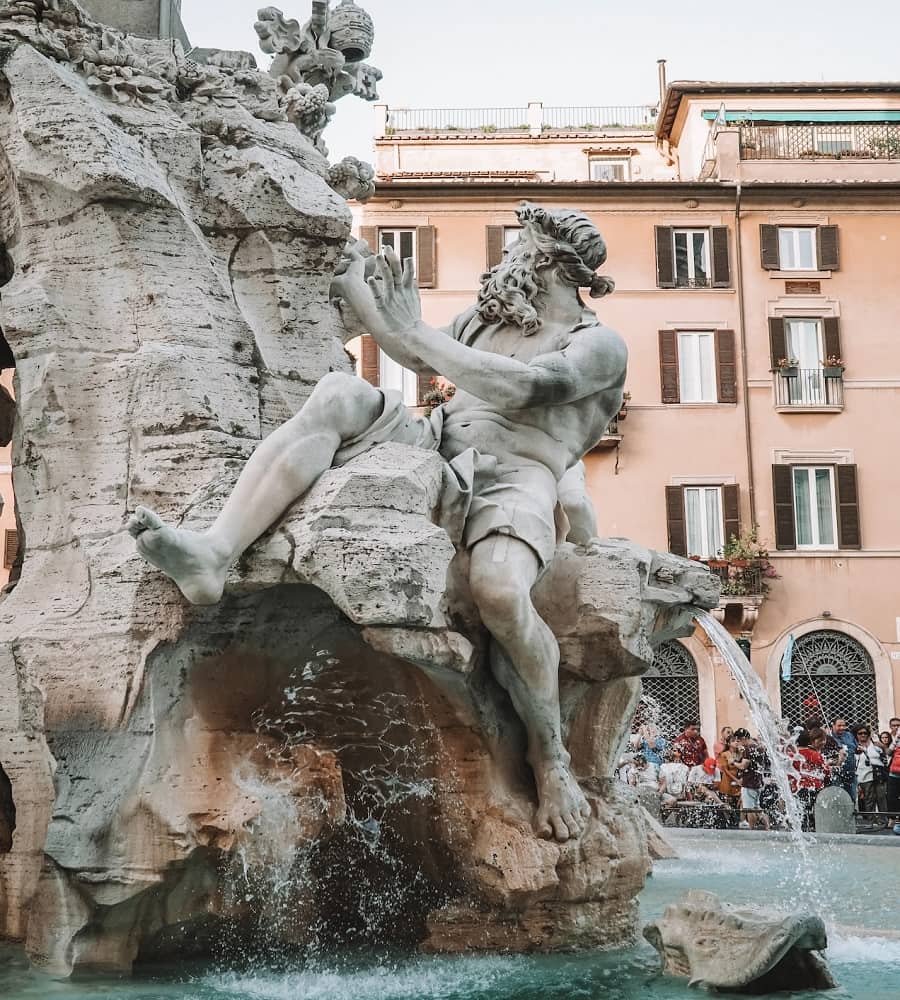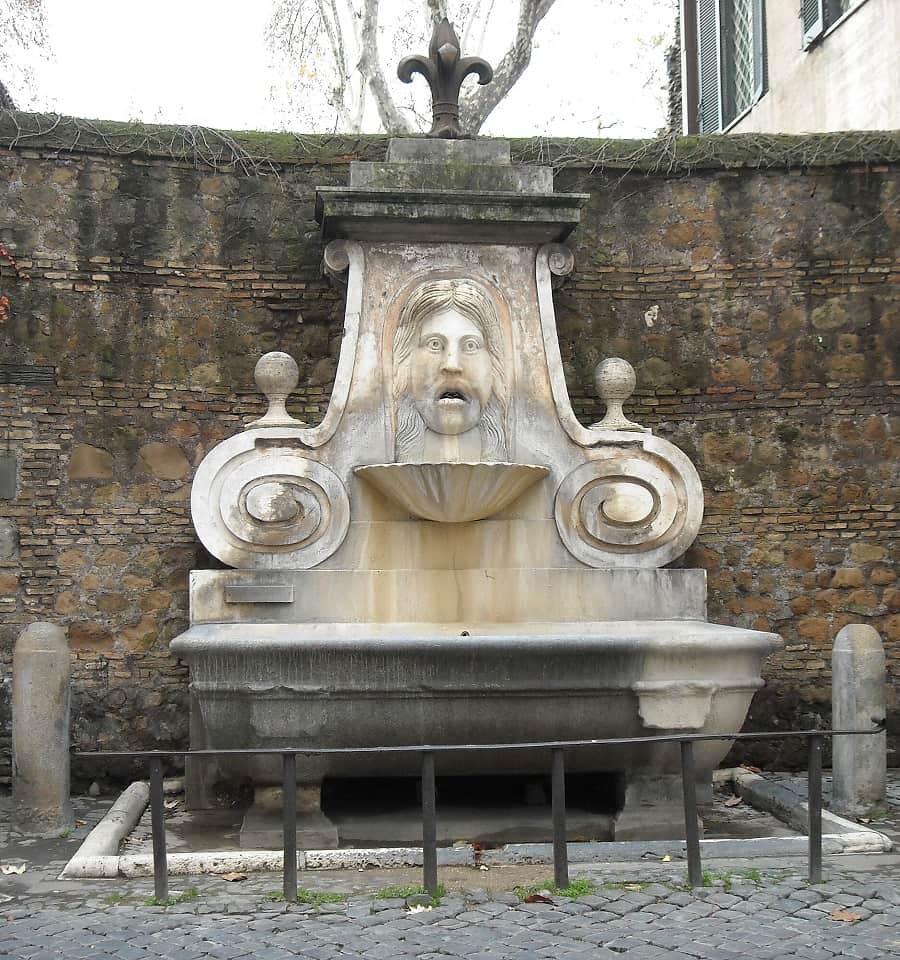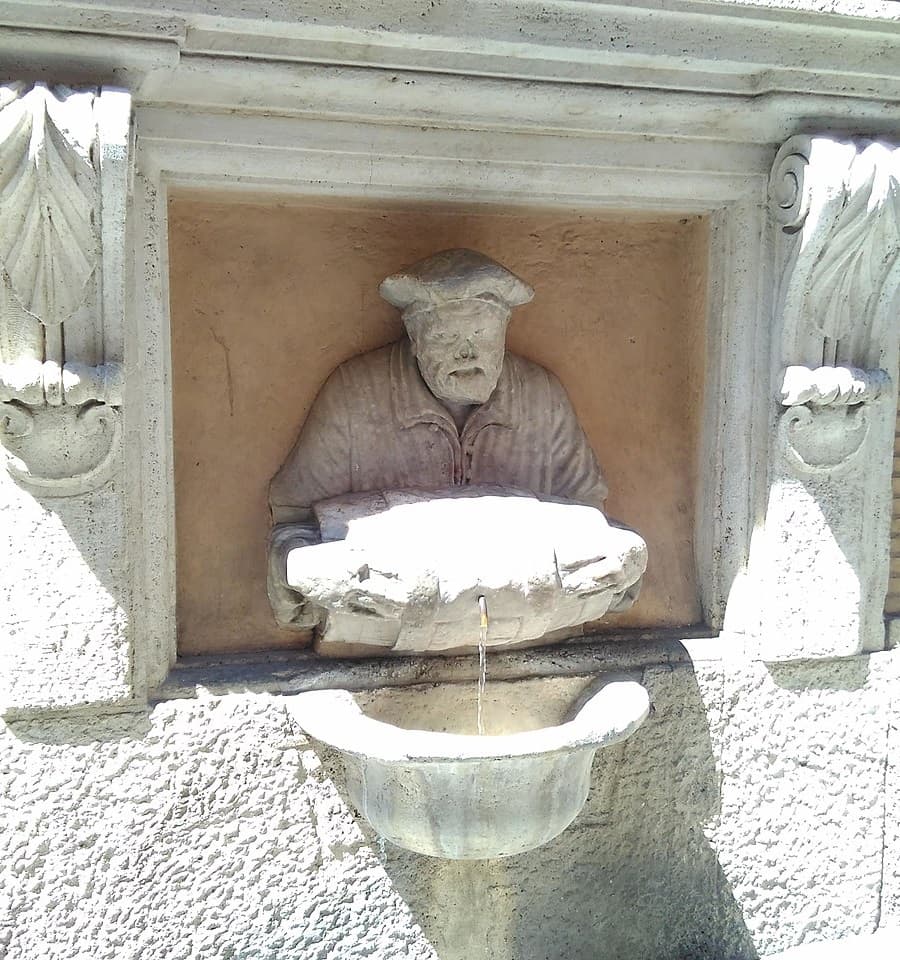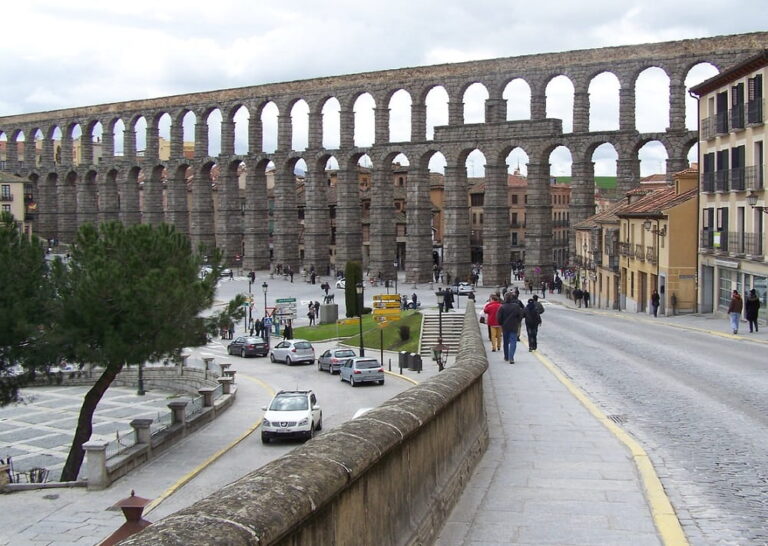Top 20 Famous Fountains in Rome
Last Updated on 4th December 2023 by admin
Rome, the Eternal City, is known for its rich history, stunning architecture, and, of course, its magnificent fountains. These iconic landmarks have been captivating visitors for centuries with their grandeur, artistic beauty, and the soothing sound of flowing water.
In this article, we will explore the top 20 most famous fountains in Rome, we shall navigate through the history, significance, and exquisite craftsmanship that define each of these enchanting landmarks. These architectural marvels have stood the test of time, captivating hearts and minds with their sheer grandeur and artistic finesse. From mythological narratives to architectural brilliance, let us uncover the captivating stories etched in stone and water.
1) Fontana di Trevi (Trevi Fountain)
The Trevi Fountain is most famous fountain in Rome and iconic landmark of ancient city, is a masterpiece that encapsulates the essence of the city’s artistic and cultural heritage. Designed by Nicola Salvi and completed in 1762, the fountain stands as a grand embodiment of Baroque architecture. Its history is intertwined with Roman mythology and the aqueduct that once supplied water to the ancient city.
The fountain’s central figure, Neptune, the Roman god of the sea, is flanked by two Tritons, symbolic of the contrasting moods of calm and tempestuous waters. The grandeur of the Trevi Fountain is heightened by its colossal size and intricate details, portraying the mastery of its sculptors. The backdrop of the Palazzo Poli adds to the dramatic allure of the fountain, creating an immersive experience for visitors.
One of the most captivating traditions associated with the Trevi Fountain is the act of tossing coins over one’s left shoulder into the water. Legend has it that this gesture ensures a return to Rome. The fountain’s magnificence, history, and cultural significance make it an unmissable attraction of Italy for tourists and a cherished symbol of Rome’s enduring splendor.
2) Fontana dei Quattro Fiumi (Fountain of the Four Rivers)
The “Fontana dei Quattro Fiumi,” known as the Fountain of the Four Rivers, stands as a tribute to the artistic brilliance of Rome. Designed by the iconic sculptor Gian Lorenzo Bernini, this famous fountain in Rome was completed in 1651. Located in the enchanting Piazza Navona, it is a splendid embodiment of Baroque magnificence.
The fountain’s name derives from the four colossal figures that represent the four great rivers of the continents known at the time: the Nile, Ganges, Danube, and Rio de la Plata. Each figure symbolizes a different continent and is adorned with distinct attributes that characterize their respective rivers. The Nile, for instance, holds an obelisk, while the Ganges clings to an oar, symbolizing the river’s navigability.
The Fontana dei Quattro Fiumi not only showcases Bernini’s exquisite skill in sculpting but also serves as a visual narrative of the diverse and interconnected world of the 17th century. As you marvel at this iconic fountain, you’re transported back in time to an era of artistic exploration and cultural celebration, a true gem among Rome’s many treasures.
3) Fontana delle Tartarughe (Turtle Fountain)
The “Fontana delle Tartarughe,” or the Turtle Fountain, is a charming and lesser-known jewel among Rome’s famous fountains. Constructed between 1580 and 1588, this fountain adds a touch of whimsy to the city’s rich artistic landscape. Located in the Jewish Ghetto, the fountain’s history is closely tied to its surroundings.
The Fontana delle Tartarughe features four young men, each holding a tortoise beneath their feet, supporting the basin above. The turtles, seemingly engaged in a graceful dance, contribute to the fountain’s delightful appeal. The fountain’s design is attributed to Taddeo Landini and Giacomo della Porta, and its installation was completed by the sculptor Antonio della Porta.
While not as grand as some of Rome’s other fountains, the Fontana delle Tartarughe exudes a unique sense of intimacy and artistry. It’s a testament to the city’s ability to surprise and captivate at every turn. As you explore the streets of Rome, make sure to seek out this hidden gem, and you’ll discover the joy of uncovering the lesser-known wonders that contribute to the city’s timeless charm.
4) Fontana dell’Acqua Paola
The “Fontana dell’Acqua Paola,” also known as the Pauline Fountain, is a tranquil oasis nestled on the Janiculum Hill, offering resplendent views of Rome and the Tiber River. Built in 1612 under the patronage of Pope Paul V, this famous fountain in Rome is a testament to the city’s architectural grandeur.
The Fontana dell’Acqua Paola’s design is inspired by ancient Roman baths, featuring a large semicircular basin supported by columns. The central niche houses a statue of Saint Peter, and water flows from the mouths of lion heads into the basin below. The water is sourced from the Acqua Paola aqueduct, a testament to the city’s mastery of hydraulic engineering.
Beyond its artistic allure, the fountain provides a serene escape from the bustling city below. Visitors can enjoy moments of contemplation while gazing at the panoramic vistas of Rome’s historic rooftops and the meandering Tiber River. The Fontana dell’Acqua Paola invites you to experience Rome from a different perspective, where the tranquility of water meets the splendor of the Eternal City.
5) Fontana della Barcaccia
The “Fontana della Barcaccia,” an enchanting fountain in Rome, stands gracefully at the base of the famous landmark of Rome, Spanish Steps. Crafted by Pietro Bernini and his son Gian Lorenzo in the early 17th century, this iconic masterpiece carries a tale of artistic ingenuity.
The fountain takes the form of a gently rocking boat, carved from stone, as if carried by the currents of time. Water flows from the boat’s prow, creating a soothing melody that resonates with the heart of the city. The Fontana della Barcaccia was born from a practical need to address low water pressure, yet it has transformed into a symbol of beauty and resilience.
This serene fountain embodies Rome’s spirit—undaunted by challenges, creating beauty from necessity. As you stand before it, you’re embraced by the serenity of its design and the echoes of history. The Fontana della Barcaccia invites you to pause, reflect, and marvel at the harmony between nature’s elements and human craftsmanship—a testament to Rome’s timeless allure and creativity.
6) Fontana del Tritone
The “Fontana del Tritone,” a magnificent jewel among Rome’s famous fountains, was sculpted by the renowned Gian Lorenzo Bernini in 1642. This iconic masterpiece, located in the heart of Piazza Barberini, pays homage to the sea god Triton, son of Poseidon.
At the fountain’s center, Triton emerges from the waters, holding a giant conch shell from which water gracefully cascades. The sculpture’s dynamic energy captures the essence of the sea, and its fine details reflect Bernini’s exceptional skill. The Fontana del Tritone serves as a testament to the Baroque era’s fascination with movement and emotion.
The fountain’s design exudes both grandeur and intimacy, seamlessly integrating into the urban landscape. Its symbolism of the sea’s power and majesty resonates with Rome’s history as a maritime empire. The Fontana del Tritone stands not just as a remarkable artistic achievement, but also as a reminder of the city’s connection to water and its eternal artistic legacy. As you marvel at its splendor, you’re transported to an era of artistic expression that continues to captivate and inspire.
7) Fontana del Moro
The “Fontana del Moro,” also known as Fountain of the Moro an exquisite treasure among Rome’s famous fountains, graces the Piazza Navona. Designed by Giacomo della Porta in 1570 and later adorned with sculptures by Gian Lorenzo Bernini, this fountain weaves history and artistry into a harmonious masterpiece.
At the fountain’s core stands a central figure of a Moor, carved by Bernini, wrestling with a dolphin. Water flows from the dolphin’s mouth, adding movement and vitality to the scene. The fountain’s original design by della Porta included just the basin and central figure, but Bernini’s addition elevated its artistic significance.
The Fontana del Moro’s history reflects Rome’s ability to evolve while preserving its past. The Moor’s presence alludes to the exotic and diverse influences that shaped the city. As you gaze at the fountain’s flowing waters, you’re reminded of Rome’s rich cultural tapestry and the artistic prowess that defined the Renaissance era.
8) Fontana delle Api (Fountain of the Bees)
The “Fontana delle Api,” an exquisite example of Roman craftsmanship, graces the charming Piazza Barberini. Crafted by Gian Lorenzo Bernini in 1644, this famous fountain in Rome is a celebration of nature’s delicate wonders. The fountain’s name, meaning “Fountain of the Bees,” alludes to the centerpiece—a large stone beehive from which water flows.
The bees, symbolizing the Barberini family crest, dance around the hive, evoking a sense of industriousness and community. The design’s intricate details and lifelike quality showcase Bernini’s mastery. Commissioned by Pope Urban VIII, the Fontana delle Api has a dual role: artistic expression and commemoration of the Barberini family’s influence.
In the heart of Rome, the Fontana delle Api is a small marvel that encapsulates the city’s grandeur. It invites you to pause, observe, and appreciate the harmony between human ingenuity and the beauty of the natural world—a theme that resonates through Rome’s history and its renowned artistic treasures.
9) Fontana del Pantheon
The “Fontana del Pantheon,” an exquisite jewel nestled near the iconic and famous Roman building, Pantheon. It is a poetic testament to Rome’s harmonious blend of architecture and water. Built in 1575 by Giacomo Della Porta, this famous fountain in Rome complements the majesty of its surroundings.
The fountain’s central element is an ancient Egyptian obelisk, soaring gracefully skyward, symbolizing the city’s timeless connection to both antiquity and innovation. Water cascades from its basin, creating a soothing melody that interweaves with the bustling sounds of the city. The Fontana del Pantheon’s design exudes an understated elegance, mirroring the Roman ethos of celebrating simplicity.
The fountain serves as a serene backdrop to the grandeur of the Pantheon, showcasing Rome’s artistry in both architecture and water engineering. Its presence offers a tranquil oasis in the heart of the city, inviting passersby to rest and reflect. The Fontana del Pantheon beckons visitors to experience Rome’s ability to seamlessly merge history, architecture, and water—a symphony that epitomizes the Eternal City’s enduring allure.
10) Fontana delle Naiadi
The “Fontana delle Naiadi,” a captivating landmark in Rome’s Piazza della Repubblica, is a celebration of mythical beauty and aquatic splendor. Designed by Mario Rutelli and unveiled in 1901, this fountain pays homage to the city’s deep-rooted connection to water and myth.
The fountain’s centerpiece features four bronze sculptures representing water nymphs, or Naiads, each surrounded by aquatic creatures. The Naiads symbolize the major rivers of Italy: the Tiber, Nile, Danube, and Arno. With graceful gestures, they embody the spirit of flowing water, adding a touch of enchantment to the bustling square.
The Fontana delle Naiadi’s location, in the heart of modern Rome, speaks to the city’s ability to blend tradition with progress. The fountain is a tribute to both artistic expression and the essential role of water in sustaining life and culture. As water cascades from the figures’ hands, it’s a reminder of the flowing currents that have shaped Rome’s history and identity.
11) Fontana dell’Acqua Felice
The “Fontana dell’Acqua Felice,” a triumph of restoration and history, graces the Quirinal Hill in Rome. Commissioned by Pope Sixtus V in the late 16th century, this fountain commemorates the restoration of an ancient Roman aqueduct, bringing fresh water to the city.
The fountain’s central element is a grand obelisk, a symbol of both ancient Egypt and Rome’s enduring legacy. Water flows from the obelisk’s base into a basin, offering a gentle reminder of the precious resource that has sustained the city for centuries. The Fontana dell’Acqua Felice’s design marries utility with artistic expression, embodying Rome’s ability to blend function and beauty.
The fountain’s name, meaning “Happy Water,” reflects the joy of a city revitalized by the restoration of its water supply. As you stand before this historic landmark, you’re invited to reflect on the intricate relationship between infrastructure, art, and the resilience of a city that has withstood the test of time.
12) Fontana delle Rane (Fountain of the Frogs)
The “Fontana delle Rane,” a delightful and whimsical fountain in Rome, is tucked away in the charming Piazza delle Cinque Scole. Crafted by Giacomo della Porta in the late 16th century, this fountain captures the essence of unexpected joy amidst the city’s historic surroundings.
The fountain features four bronze frogs, frozen in playful mid-leap, seemingly engaged in a lighthearted dance, hence it is called “Fountain of the Frogs”. Water flows from their mouths, adding a musical quality to their frolic. The Fontana delle Rane’s design brings a touch of enchantment to the square, reminding visitors of the joy that can be found in the simplest of moments.
This quaint fountain embodies Rome’s multifaceted character—where history, art, and whimsy intersect. As you encounter the Fontana delle Rane, you’re reminded that even amidst the weight of history, there’s room for playful surprises. The fountain invites you to pause, smile, and appreciate the unexpected delights that the Eternal City has to offer, embracing the spirit of discovery that defines Rome’s enchanting streets.
13) Fontana della Pigna
View this post on Instagram
The “Fontana della Pigna,” a hidden gem among Rome’s fountains, can be found within the Vatican City. This intricately designed masterpiece graces the Cortile della Pigna, a serene courtyard within the Vatican’s Belvedere Palace. The Pine Cone Fountain consists of a massive bronze pine cone, which is believed to have been part of a Roman fountain that dates back to ancient Roman times. Its precise age and origin are not definitively known, but it is thought to have been created during the 1st or 2nd century AD.
This ornamental pine cone, which stands about 4 meters (13 feet) tall, is believed to have adorned a Roman fountain or garden in antiquity. Today, the Fontana della Pigna is displayed prominently in the Vatican Museums’ courtyard, where visitors can admire its historical significance and intricate detailing as they explore the rich art and culture housed within the Vatican’s vast collection.
The fountain’s name translates to “Pine Cone Fountain,” and its central element is a colossal bronze pine cone, a symbol of fertility and regeneration. This pine cone was originally part of a colossal Roman fountain in the ancient Campus Martius. Nestled within the Vatican’s walls, the Fontana della Pigna is a reminder of the city’s artistic legacy and the continuity of inspiration across centuries. Surrounded by the Vatican’s historic architecture, the fountain invites contemplation and reflection.
14) Fontana di Nettuno (Neptune Fountain)
The “Fontana di Nettuno,” known as the Neptune Fountain, is a commanding presence in Rome’s Piazza Navona. Designed by Giacomo della Porta and later embellished by Antonio Della Bitta, this impressive fountain pays homage to the god of the sea.
Completed in 1574, the Fontana di Nettuno features Neptune, the Roman god of the sea, standing atop a shell-shaped chariot pulled by seahorses. The fountain’s grandeur and intricate details highlight the skill of its sculptors, while the four Tritons at the corners add a dynamic energy to the scene. The Neptune Fountain exudes a sense of power and authority, reflecting the city’s maritime history.
This famous fountain in Rome, surrounded by the splendor of the Piazza Navona, the Fontana di Nettuno serves as a majestic centerpiece. The gushing waters and the commanding figure of Neptune evoke a sense of awe and admiration, inviting visitors to marvel at Rome’s artistic legacy. As you stand before this fountain, you’re reminded of the city’s connection to water, myth, and the enduring spirit that defines the Eternal City.
15) Fontana del Mascherone
The “Fontana del Mascherone,” a lesser-known gem among Rome’s fountains, can be discovered in the Trastevere district. Crafted in the 17th century, this quaint fountain carries a unique charm that captures the essence of its historic surroundings.
The fountain takes its name from the “mascherone,” a decorative mask that adorns its central column. Water playfully gushes from the mascherone’s mouth, creating a gentle and soothing melody. The Fontana del Mascherone’s design is attributed to Giovanni Vasanzio, and it reflects the artistic sensibilities of its time, characterized by elegance and simplicity.
This fountain stands as a quiet witness to the passage of time, nestled among the cobblestone streets of Trastevere. Its unassuming presence invites contemplation and reflection, offering a glimpse into the everyday life of the city. As you encounter the Fontana del Mascherone, you’re reminded that even amidst Rome’s grandeur, there are moments of simplicity and authenticity waiting to be discovered—a charming reminder of the city’s enduring appeal.
16) Fontana dei Libri (Fountain of the Books)
The “Fontana dei Libri,” also known as the Fountain of the Books, is a unique and intellectual marvel hidden within the Vatican City. Nestled in the Cortile del Belvedere, this fountain offers a refreshing departure from Rome’s traditional aquatic artworks.
Designed by Giuseppe Valadier in the 19th century, the Fontana dei Libri features cascading waterfalls that flow over a stack of open books. The books symbolize knowledge, learning, and the pursuit of wisdom—a fitting homage to the Vatican’s role as a center of scholarship and spirituality. The fountain’s elegant design and symbolic representation showcase Valadier’s mastery.
Surrounded by the Vatican’s historic architecture and serene courtyards, the Fountain of the Books evokes a sense of introspection and contemplation. As you stand before this unique fountain, you’re reminded of the timeless importance of knowledge and the city’s deep connection to both intellectual pursuits and artistic expression. The Fontana dei Libri invites you to reflect on the power of ideas, making it a true treasure within the Vatican’s rich tapestry.
17) Fontana della Navicella
The “Fontana della Navicella,” a graceful and evocative fountain in Rome, graces the grounds of the Basilica di Santa Maria in Domnica on the Caelian Hill. The Fontana della Navicella is believed to have been originally constructed during the reign of Pope Leo X in the early 16th century, around the year 1519. It is an important work attributed to the famous Renaissance artist and sculptor Andrea Sansovino.
The fountain takes its name from the “navicella,” a small ship depicted in the central basin, symbolizing the voyage of faith. Water flows gently from the ship’s hull, adding a soothing rhythm to the scene. The Fontana della Navicella’s design reflects the Renaissance’s fascination with classical themes and natural forms.
This fountain serves as a tranquil pause for reflection, nestled within the courtyard of the Basilica. Its presence offers a moment of respite from the bustling city, inviting visitors to ponder the connection between faith and the journey of life. As you encounter the Fontana della Navicella, you’re reminded of the timeless quest for spiritual fulfillment and the city’s ability to seamlessly integrate art, architecture, and devotion—an exquisite fusion that characterizes Rome’s enduring allure.
18) Fontana degli Artisti
The “Fontana degli Artisti,” a hidden gem in the heart of Rome, is a testament to the city’s reverence for creativity and artistic expression. Created in the 20th century by Pietro Lombardi, this charming fountain captures the essence of the artistic spirit that has always thrived in the Eternal City.
The fountain features a sculpture of an artist working on a canvas, surrounded by other elements symbolizing various artistic disciplines. Water gently flows from the artist’s paintbrush, adding a touch of whimsy to the scene. The Fontana degli Artisti serves as a tribute to the city’s rich cultural heritage and its vibrant community of creators.
Located near Piazza Fiume, this fountain offers a tranquil escape from the city’s hustle and bustle. Its presence invites contemplation and reflection on the role of art in shaping Rome’s identity. As you encounter the Fontana degli Artisti, you’re reminded of the city’s ongoing commitment to nurturing creativity and its enduring legacy as a haven for artists from all corners of the world—a vibrant tribute to the power of imagination and innovation.
19) Fontana della Botte (Fountain of the Barrels)

The “Fontana della Botte,” also known as the Fountain of the Barrels, is a unique and charming fountain nestled in the Trastevere district of Rome. This whimsical fountain, dating back to the 17th century, adds a touch of rustic beauty to the city’s historic streets.
The fountain gets its name from the large wine barrels that adorn its structure. Water flows from the barrels into a central basin, creating a soothing ambiance that reflects the simplicity of life in bygone eras. The Fontana della Botte’s design captures the essence of a traditional Italian courtyard, where water was once collected for daily use.
This fountain stands as a quiet testament to Rome’s rich history and the importance of water in daily life. Its unpretentious charm invites passersby to pause and reflect on the city’s enduring traditions. As you encounter the Fontana della Botte, you’re transported to a time when community life revolved around shared spaces and simple pleasures—a picturesque reminder of Rome’s timeless charm and the stories it holds within its streets.
20) Fontana del Facchino (Fountains of the Porter)
The “Fontana del Facchino,” a captivating fountain tucked away in the heart of Rome, is a delightful ode to the city’s working class. Crafted in the 16th century, this fountain captures the spirit of everyday life and the vibrant energy of its historic surroundings.
The fountain’s centerpiece is a bronze statue of a porter, or “facchino,” carrying a barrel on his shoulder. Water playfully flows from the barrel, adding movement and charm to the scene. The Fontana del Facchino’s design pays homage to the laborers who played an integral role in the city’s bustling streets.
Located in the colorful Piazza delle Cinque Scole, this fountain offers a quiet retreat from the city’s more well-known landmarks. Its unassuming presence invites contemplation on the resilience and camaraderie of the working class. As you encounter the Fontana del Facchino, you’re reminded of Rome’s diverse tapestry of life and the stories of the people who have shaped the city’s history—a charming tribute to the everyday heroes who make Rome come alive.
Rome’s fountains are not just sources of water; they are living pieces of art, each with its own story and significance. These top 10 fountains in Rome showcase the city’s rich history, artistic heritage, and enduring charm. Exploring these fountains allows you to immerse yourself in the timeless beauty of the Eternal City, where history and art come together in perfect harmony. Each fountain stands as a testament to human creativity’s boundless potential, offering a window into the past while inspiring generations to come. As we navigate the stories, symbolism, and intricate craftsmanship that define these fountains, we are reminded of the enduring power of art to transcend time and leave an indelible mark on the human experience.
























